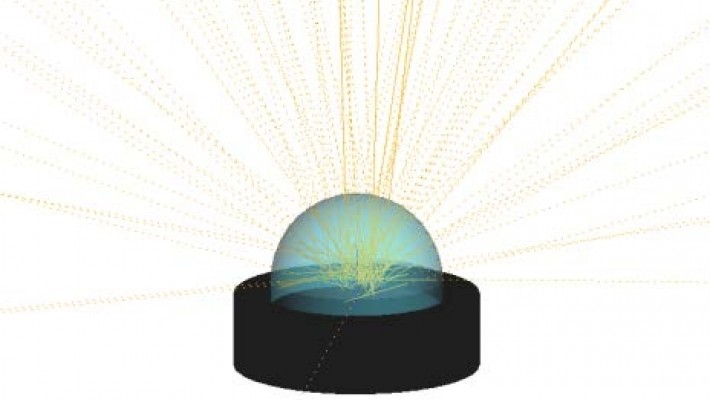Blog


Advanced LED Modeling Techniques with FRED Software
Light Emitting Diodes (LEDs) have become the preferred choice over incandescent light sources for most applications due to their compact size, high power efficiency, and long lifespan. However, LEDs present certain challenges such as the need for color mixing and collimation. In this blog post, we'll explore how FRED software facilitates the modeling and optimization of LED systems through three examples: an LED flashlight, a color-mixing lightpipe, and a hybrid collimator lens.
Example 1: LED Flashlight
The first example models a flashlight with three white LEDs arranged in a triangular configuration. The LED geometry is based on the basic LED sample file available in FRED.

Figure 1: Flashlight model in FRED, including the body, faceted reflector, and arrangement of three white-light LEDs.
To enhance optical efficiency, a faceted reflector is placed behind the LEDs. The reflector is created using a custom element with a surface of revolution based on a segmented curve.

Figure 2: Breakpoint coordinates for the segmented curve and parameters for the surface of revolution.
The performance of the flashlight is analyzed at various distances, showing the collimation of emitted light can be optimized by adjusting the reflector's shape.
.png)
Figure 3: Color image from flashlight illumination at 0.1 m (left) and 0.5 m (right).
Example 2: Color-Mixing Lightpipe
Another application involves creating white light by mixing red, green, and blue LEDs. When placed close together, the color mix becomes uniform at a sufficient distance, but irradiance spreads over a larger area.

Figure 4: Color image at 14.5 mm (left) and 100 mm (right) from the RGB LEDs.
To achieve uniform color mixing within a controlled area, a plastic hexagonal lightpipe is modeled. This lightpipe is created using a Boolean operation on rectangular blocks to form a hexagonal rod.
.png)
Figure 5: Creation of a hexagonal rod using an Element Boolean function.
After ray tracing through the lightpipe, adjustments to the relative power output among the LEDs result in achieving white light.
.png)
Figure 6: Color image at the end of a 100 mm long hexagonal lightpipe with equal (left) and adjusted (right) RGB power output.
Example 3: Hybrid LED Collimator Lens
For applications requiring directional control over light output, a hybrid refractive/reflective collimator lens can be designed. This lens combines a positive axicon for small angles and sloped parabolic sides for larger angles using total internal reflection.
.png)
Figure 7: Schematic raytrace of a hybrid collimator lens above a LUMILEDS Rebel Amber LED.
The collimating capability is evaluated by comparing intensity distribution on a detector plane 1 m away from the LED, both with and without the collimator.

Figure 8: Intensity from LUMILEDS Rebel Amber LED without (top) and with (bottom) hybrid collimating lens.
Conclusion
LEDs are versatile and widely used in various applications, each requiring specific performance characteristics in terms of intensity, irradiance distribution, color mixing, and uniformity. FRED software provides powerful tools to model, optimize, and simulate these optical systems effectively.
___________________________________________________________________________________________________________________________________________________________________________________
This blog post was created based on the information provided by Photon Engineering, a partner of CBS Europe.
Download the PDF: FRED Application Note - LEDs

